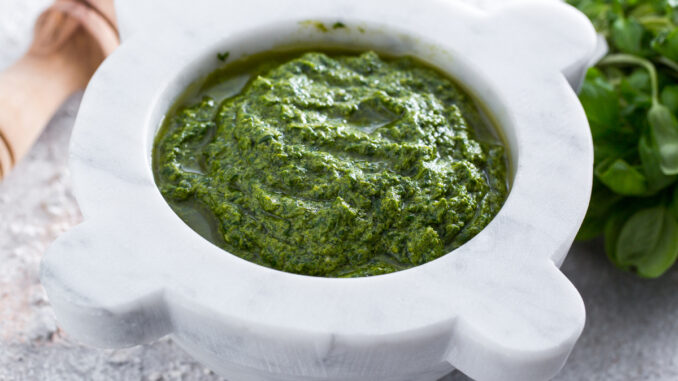
Introduction:
Pesto alla Genovese, the verdant masterpiece of Italian cuisine, stands as a culinary ambassador from the coastal region of Liguria. This basil-forward, herbaceous sauce is a testament to the vibrant flavors and culinary finesse that characterize Italian gastronomy. In this extensive exploration, we will embark on a journey through the history of Pesto alla Genovese, tracing its origins, and unravel the secrets behind crafting the perfect rendition of this iconic sauce. From its humble beginnings in Ligurian kitchens to its global prominence, Pesto alla Genovese beckons us to immerse ourselves in the fragrant world of fresh herbs, garlic, pine nuts, and Parmesan.
Section 1: Origins and Historical Roots
1.1 Birthplace of Pesto:
Pesto alla Genovese hails from the port city of Genoa in the Liguria region of Italy. Historically, the word “pesto” comes from the Italian verb “pestare,” meaning to pound or crush. The sauce’s origins can be traced back to the 16th century, where it emerged as a staple in the maritime republic’s culinary repertoire.
1.2 Early Variations:
Early iterations of pesto featured regional variations, with ingredients reflecting the agricultural abundance of Liguria. The rugged terrain, rich in olive groves and fragrant basil, laid the foundation for the iconic green sauce we know today.
Section 2: Ingredients That Define Pesto alla Genovese
2.1 Fresh Basil:
At the heart of Pesto alla Genovese lies the aromatic basil. The Genovese basil, with its distinct sweet and peppery notes, is a key ingredient that imparts the sauce’s signature flavor. The use of young basil leaves ensures a delicate, vibrant taste.
2.2 Pine Nuts:
Pine nuts contribute a subtle nuttiness and creaminess to the pesto. Toasting them before adding to the sauce enhances their flavor, creating a harmonious balance with the basil and other ingredients.
2.3 Garlic:
Garlic provides the characteristic pungency to Pesto alla Genovese. While the quantity can be adjusted to personal preference, the garlic’s raw, robust essence is essential for the sauce’s authentic profile.
2.4 Parmesan and Pecorino:
A combination of Parmesan and Pecorino cheeses adds a savory depth to the pesto. Grating these cheeses fresh ensures a rich, umami flavor that complements the other ingredients.
2.5 Extra Virgin Olive Oil:
Liguria’s renowned extra virgin olive oil serves as the foundation for Pesto alla Genovese, enhancing its luscious texture and contributing a distinctive fruity undertone.
Section 3: The Traditional Pesto alla Genovese Recipe
3.1 Ingredients:
- 2 cups fresh Genovese basil leaves, packed
- 1/2 cup pine nuts, toasted
- 3 cloves garlic, peeled
- 1/2 cup Parmesan cheese, freshly grated
- 1/4 cup Pecorino cheese, freshly grated
- 1/2 cup extra virgin olive oil
- Salt, to taste
3.2 Instructions:
- In a food processor, combine basil, pine nuts, and garlic. Pulse until coarsely chopped.
- Add Parmesan and Pecorino cheeses. Pulse again to combine.
- With the food processor running, slowly stream in the olive oil until the mixture forms a smooth, emulsified sauce.
- Season with salt to taste, adjusting as needed.
3.3 Note on Texture:
Pesto alla Genovese should have a slightly coarse texture, with visible specks of basil. Avoid over-processing to maintain its rustic appeal.
Section 4: Pesto alla Genovese in Traditional Ligurian Cuisine
4.1 Classic Pairings:
In Ligurian kitchens, Pesto alla Genovese finds its way into an array of traditional dishes. The most iconic pairing is with trofie, a spiral-shaped pasta that cradles the sauce beautifully. Other regional favorites include trenette, potato gnocchi, or simply spread on fresh bread.
4.2 Cultural Significance:
Pesto alla Genovese holds cultural significance beyond its culinary prowess. The annual “World Pesto Championship” in Genoa gathers enthusiasts to celebrate the art of making pesto, reinforcing its role as a cultural heritage.
Section 5: Pesto alla Genovese Goes Global
5.1 International Adaptations:
As Pesto alla Genovese gained global recognition, chefs around the world embraced the sauce, incorporating it into diverse culinary creations. From pizzas and salads to sandwiches and seafood, the versatility of pesto transcends cultural boundaries.
5.2 Store-Bought Convenience:
With the rise of global appreciation, pre-packaged pesto sauces became widely available, offering convenience to home cooks while introducing Pesto alla Genovese to new audiences.
Section 6: Pesto alla Genovese in Contemporary Cuisine
6.1 Fusion Inspirations:
In modern gastronomy, Pesto alla Genovese has become a source of inspiration for fusion dishes. Creative chefs experiment with diverse herbs, nuts, and cheeses, offering innovative twists on the classic sauce.
6.2 Health-Conscious Variations:
As dietary preferences shift, health-conscious adaptations of Pesto alla Genovese have emerged. Nutritional alternatives, such as using walnuts or almonds, cater to those seeking lighter options without compromising on flavor.
Section 7: Pesto alla Genovese and the Slow Food Movement
7.1 Embracing Tradition:
Pesto alla Genovese aligns with the principles of the Slow Food movement, emphasizing the importance of preserving traditional culinary practices, supporting local ingredients, and savoring meals mindfully.
7.2 Sustainability and Locality:
The Slow Food philosophy encourages the use of locally sourced, sustainable ingredients, echoing the ethos of Ligurian kitchens that have cherished the bounty of their region for centuries.
Conclusion:
Pesto alla Genovese, with its aromatic symphony of fresh basil, garlic, pine nuts, and cheeses, encapsulates the essence of Ligurian cuisine. From its humble beginnings in Genoa to its global recognition, this iconic sauce has transcended culinary boundaries while remaining deeply rooted in tradition. As you embark on your Pesto alla Genovese journey, savor the fragrant harmony of its ingredients, and let the spirit of Liguria guide you through a culinary adventure that spans centuries. Buon Appetito!